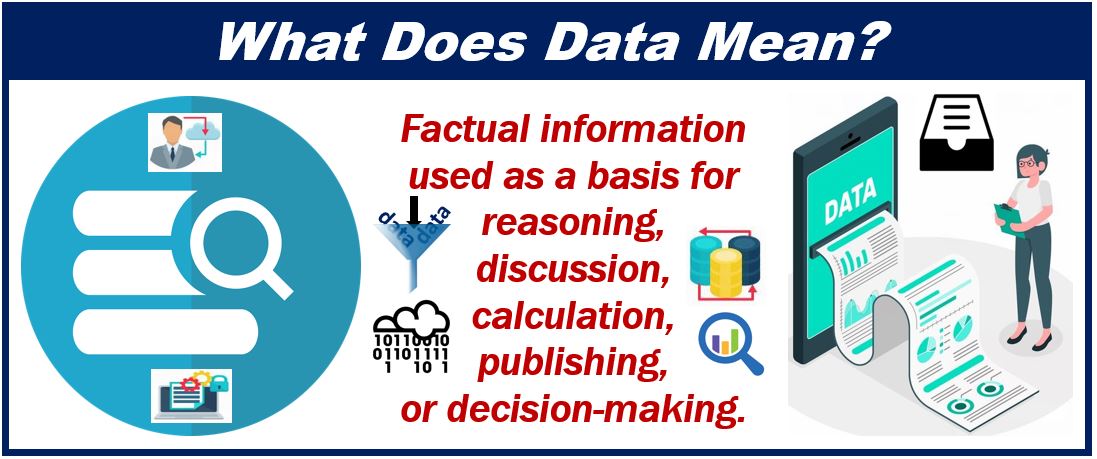What is data? Definition and examples
Data means information, more specifically facts, figures, measurements and amounts that we gather for analysis or reference. The term’s meaning also includes descriptive information about things, plants, animals, and people. We collect and store data typically through observation.

We gather facts and numbers, which we examine and consider when trying to make, for example, a business decision. These facts and figures are data, as is electronic information that we store, and our computers or smartphone use.
Data is the plural of datum. However, most people tend to use the word data for both the plural and singular forms.
The Cambridge Dictionary has the following definition of the term:
“Information, especially facts or numbers, collected to be examined and considered and used to help decision-making, or information in an electronic form that can be stored and used by a computer.”
Quantitative and qualitative data
For scientists, mathematicians, statisticians, entrepreneurs, and lawmakers, there are two main types of data:
- Qualitative – it describes things, i.e., it is descriptive information.
- Quantitative – numerical information, i.e., numbers, statistics, measurements, etc.
Let’s look at an example of the two types in a context:
What do we know about Sammy the Cat?

Qualitative
- He is black all over except for his paws, chest, chin, and part of his tummy, which are white.
- His hair is short-to-medium in length.
- He spends most of the day asleep and tends to go out at night.
Quantitative
- His tail is 30cm (18″) long.
- He weighs 5kg (11.2lbs).
- Sammy has one sister and one brother.
- He is 40cm (15.7″) long (excluding tail).
Big data

Big data consists of at least one petabyte of information. One petabyte (PB) is 1015 or 10,000,000,000,000,000 bytes of digital information. We describe it as having the 5Vs: value, volume, variety, velocity, and veracity.
Wikipedia.org says the following:
“Big data is a field that treats ways to analyze, systematically extract information from, or otherwise deal with data sets that are too large or complex to be dealt with by traditional data-processing application software.”
In today’s fiercely competitive marketplace, companies are daily inundated with huge volumes of data; both unstructured and structured. However, what matters is not how much information there is, but what businesses do with it. CEOs and members of senior management analyze these massive pools of information for insights which can help them predict outcomes and make better decisions.
-
Big data in retail
In the retail sector, big data today has become essential. Without it, any online store would struggle to compete effectively.
According to sas.com, if we analyze this type of information carefully, we might achieve the following benefits for our businesses:
- Lower costs.
- Better use of time.
- Development of new products.
- Optimized offerings.
- Smarter decision-making.
Sas.com makes the following comment about how we use business information today:
“Big data – and the way organizations manage and derive insight from it – is changing the way the world uses business information.”
Etymology
Etymology refers to where words come from. It also includes the study of how the meanings of words evolved over time. Did you know that the word nice once meant silly, simple, or foolish? Awful used to mean worthy of awe.
The term Data first emerged in the English language in the 1640s. At that time, it meant “a fact given or granted.” It was the classical plural of Datum, which came from the Latin word Datum, which meant “(thing) given.” The Latin word for Give is Dare. Datum is the past participle of Dare.
The term did not acquire the meaning “numerical facts collected for future reference” until 1897.
It entered the world of computing jargon in 1946, with the meaning “transmittable and storable information by which computer operations are performed.”
The terms data processing, database, and data entry appeared in 1954, 1962, and 1970 respectively.
As the digital age progresses, the significance of data stewardship and data governance grows, emphasizing the need for ethical and efficient management of personal and corporate data.
Data – vocabulary and concept
In business and technical English, there are many compound phrases containing the word “data.” A compound phrase is a term that consists of at least two words. Let’s look at some commonly used ones, learn their meanings, and how we can use them in a sentence:
-
Data Security
Protective measures to safeguard data from unauthorized access or alterations.
Example: “The breach highlighted the importance of robust data security in protecting client information.”
-
Data Privacy
The aspect of information technology that deals with the ability an organization or individual has to determine what data in a computer system can be shared with third parties.
Example: “With new regulations, the company had to revise its policies to ensure better data privacy for its users.”
-
Data Integrity
The maintenance of, and the assurance of the accuracy and consistency of, data over its entire life cycle.
Example: “Data integrity is crucial for the credibility of the financial reports.”
-
Data Management
The practice of collecting, keeping, and using data securely, efficiently, and cost-effectively.
Example: “A good data management strategy is vital for businesses that rely on large volumes of data.”
-
Data Processing
The conversion of data into a usable and desired form.
Example: “The survey results underwent extensive data processing before the final analysis.”
-
Data Collection
The systematic gathering of information from various sources to address a particular question or measure performance.
Example: “Effective data collection methods are essential for accurate research outcomes.”
-
Data Visualization
The representation of data in a graphical format to make the analysis of complex data easier to understand.
Example: “Data visualization tools can transform spreadsheets of figures into clear graphical stories.”
-
Data Storytelling
The process of translating data analyses into layman’s terms to influence business decisions and actions.
Example: “Effective data storytelling can help stakeholders understand the implications of complex data insights.”
Two Educational Videos
These two interesting videos come from our sister channel on YouTube – Marketing Business Network. One explains what “`Data” is, and the other is all about “Data Storytelling.” Both videos use easy-to-understand vocabulary and examples.
-
What is Data?
-
What is Data Storytelling?

